Coming off a thrilling 6-1 win over Granada, Atlético Madrid entered the midweek match on a high. Looking to make it two out of two to start the season, a trip to newly-promoted Huesca.
Other than a loss to fellow promoted club Cadiz, Huesca has had a strong start to the season. Draws against Villarreal and Valencia gave them two hard-earned points.
Despite the excitement surrounding the revamped Atlético Madrid, Huesca defended brilliantly, earning another point against a team from the top half of last season’s La Liga table.
In this tactical analysis, we’ll look at the defensive structures of each team. With both sides finishing with a 0.97xG, quality chances were few and far between. This analysis will examine Atlético’s issues in attack and detail the tactical changes introduced in the late stages of the game.
Lineups
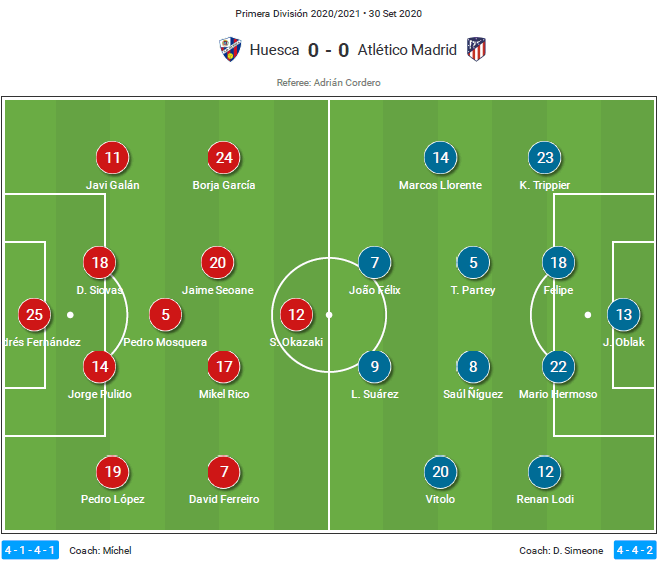
Míchel’s Huesca side, which features an incredible 20 Spaniards on the 25 man roster, featured a 4-1-4-1 with 22-year-old Álvaro Fernández in goal. The Spanish youth international was protected by a backline of Pedro López, Jorge Pulido, Dimitris Siovas and Javi Galán. Pedro Mosquera was the lone pivot with the former Real Madrid academy player, Jaime Seoane, and Mikel Rico in front of him. David Ferreiro and Borja García operated as wide attacking midfielders while Shinji Okazaki, the Japanese international and former Leicester City player, was the striker.
Diego Simeone countered with his standard 4-4-2. Jan Oblak took his place between the pipes with Kieran Trippier, Felipe, Mario Hermoso and Renan Lodi from right to left. The midfield was anchored by Thomas Partey and Saúl Ñíguez while Vitolo and Marcos Llorente played left and right mid, respectively. Up top, João Félix operated as the second striker, often dropping into the midfield to direct play. The young Portuguese was paired with the former Barcelona forward, Luis Suárez.
Pressing Structures
When a match ends in a goalless draw and sub one xG for each team, the first thing to analyse is each team’s defensive structure. Since Atlético Madrid held 60% of possession and maintained the attacking initiative for the majority of the match, we’ll start with Huesca’s pressing structure.
The Oscenses from El Alcoraz would occasionally engage Atléti high up the pitch, but the general approach was to set a midfield line of confrontation and take away access to the central channel and half spaces. Very disciplined in their 4-1-4-1, Huesca made it very difficult for Atlético to find joy in the middle of the pitch. Mosquera’s movement behind the midfield four was key to the side’s success. With Atlético Madrid consistently situating players between the lines, the holding midfielder filled the gaps and often had to position himself between two players, ready to pressure either one.
In the image below, we see Huesca firmly entrenched in their 4-1-4-1 with the midfield line of confrontation. The two lines of four defended in three out of the five vertical channel while Mosquera patrolled the space between the lines.
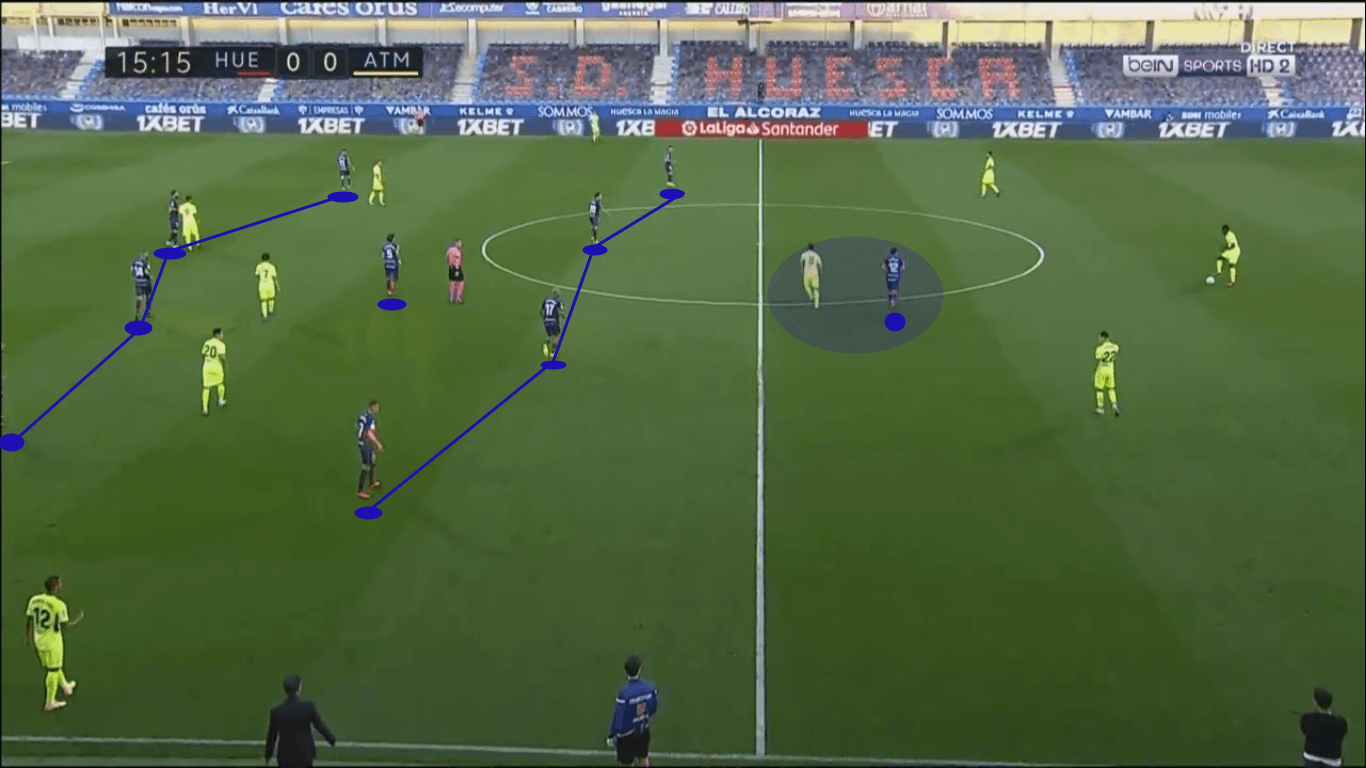
Another interesting note is the positioning of Okazaki. Rather than pushing higher to pressure Partey and funnel play into the centre-backs, the former EPL champion remained deeper to stay connected with the line of four behind him. That enabled him to pick up the checking runs of Saúl and deny service to the Spanish international.
For the game, Huesca’s PPDA (passes per defensive action) averaged 13.4, showing that they were willing to sit back, congest the centre of the pitch and engage once Atléti played into their press.
With Simeone’s men taking the attacking initiative, 57% (56 total) of Atlético Madrid’s 99 turnovers came in the attacking third while another 28% (28 total) came in the middle third. Given the number of losses in higher areas of the pitch, Los Rojiblancos were quick to counterpress. Their 8.5 PPDA, combined with 17% (59 total) of Huesca’s 352 passes going long and a 53% success rate on long passes, effectively allowed Atlético Madrid to cut out passing lanes, reducing Huesca to hit and hope for long stretches.
When the home side was able to engage in the build-out, Atlético engaged in a 4-3-1-2 high press. Félix and Suárez were the two highest players, often with Saúl underneath. The image below gives a visual of the structure. Saúl accounted for the opposition #6, Mosquera, while his forwards crept forward to force action from the keeper, Fernández, and his centre-backs.
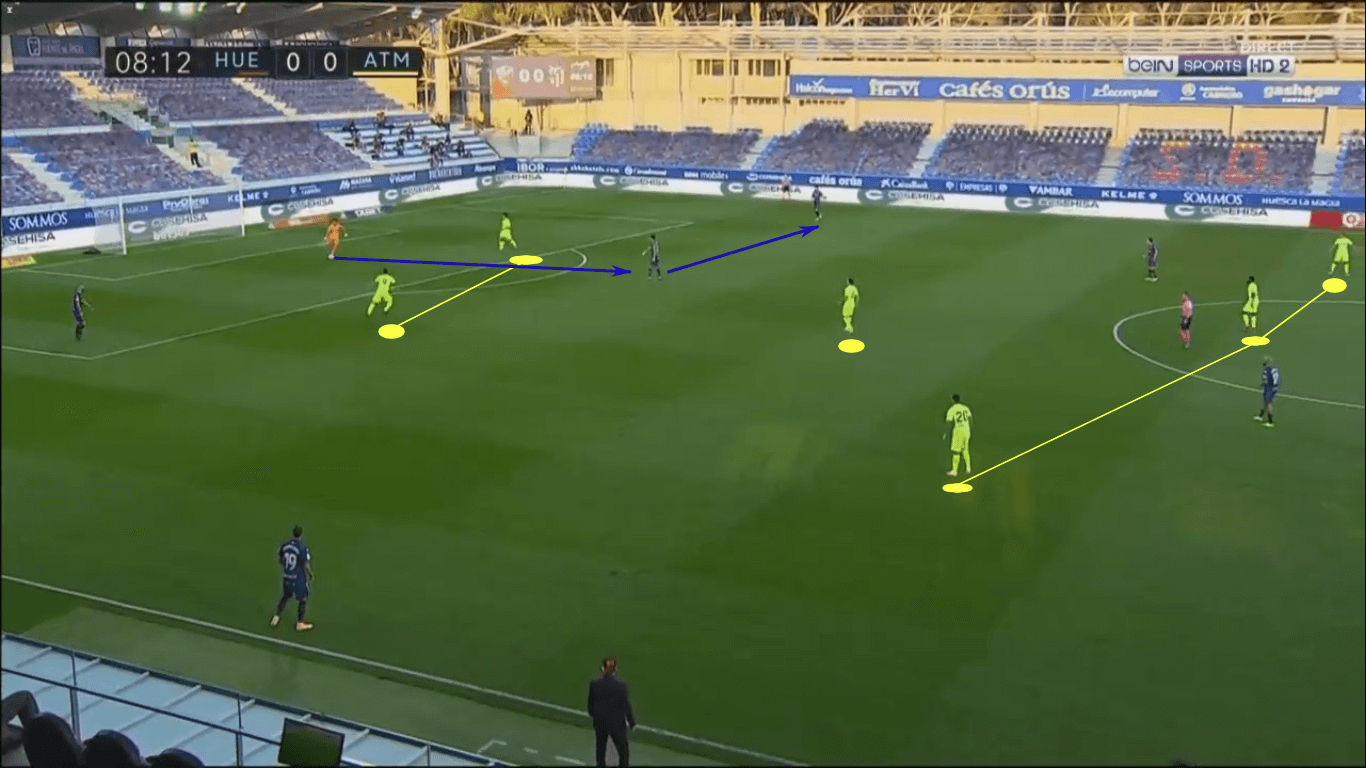
In the sequence above, Huesca was able to break the first line, playing into Mosquera, who then played into the left-wing. When the Azulgranas were able to beat the first line and play out from the back, Saúl would drop back in line with Partey, giving Atlético Madrid two banks of four in defence, as highlighted below. They maintained that shape as they defended deeper, reserving the 4-3-1-2 for the high press.
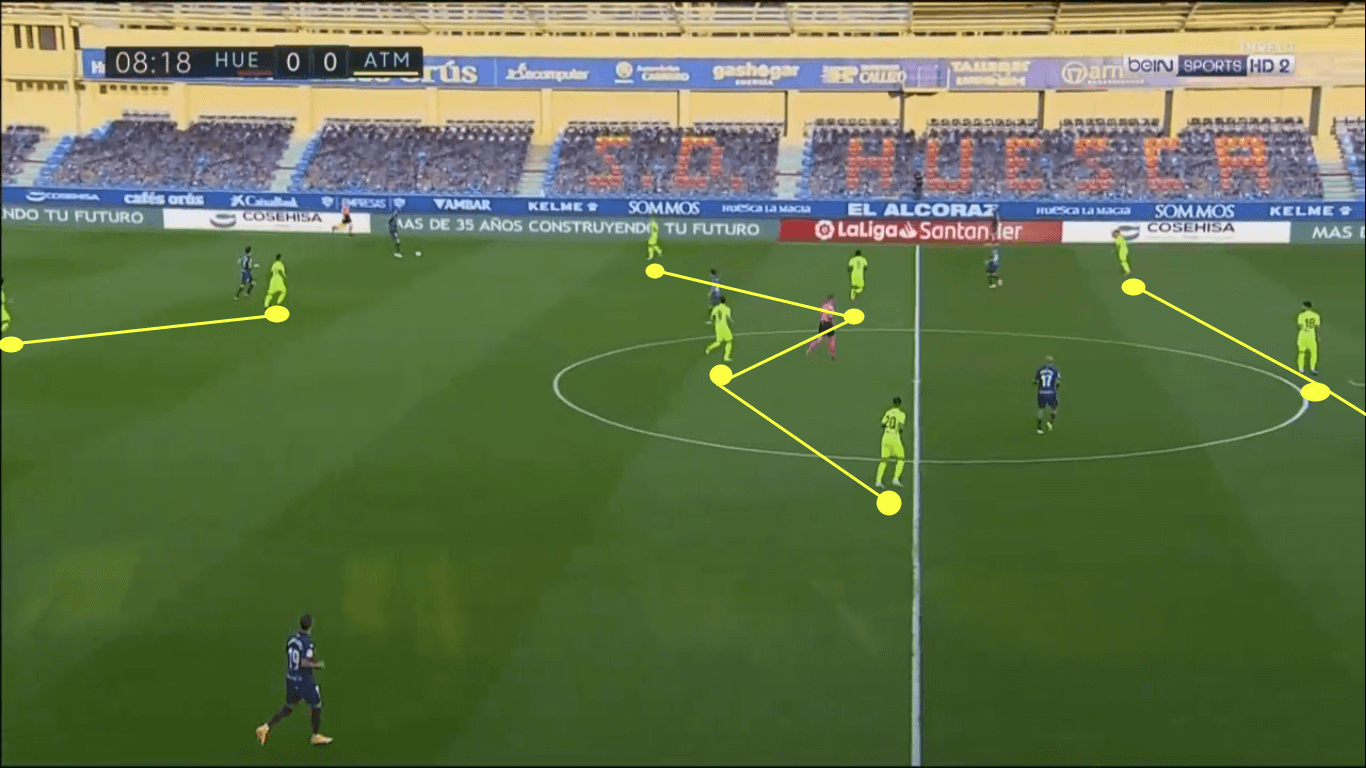
When comparing the defensive structures with each team’s starting points, it’s clear that most of Huesca’s first touches came in more defensive positions, accounting for the narrowness seen in the map below.
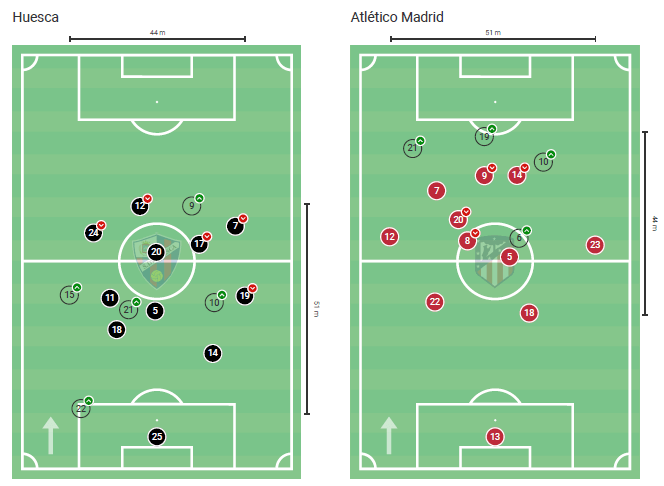
As for Los Colchoneros, many of the starting points came in the attacking half of the pitch. Given their possession total and Huesca’s midfield line of confrontation, those are reasonable starting points. Additionally, Atlético Madrid was very successful forcing turnovers in the attacking and middle thirds (72%), justifying the high points of the midfielders.
Atlético Madrid couldn’t find space
Looking at that average starting position map, you surely noticed the well-defined lines of Huesca and the two lines of three in the middle of Atlético Madrid’s formation. As mentioned, Huesca was very well organised, denying central progression. That forced Atléti to play around and over the opposition press.
When you look at that Atlético formation, the 4-4-2 transformed into a 2-5-3 in the attacking half of the pitch. Vitolo pinched inside while Llorente moved higher up the pitch, in line with the two forwards. Simeone relied on Trippier and Lodi to provide width and service into the box. The Englishman could certainly have offered a greater presence up the pitch, but he did manage a 100% success rate on his three crosses. Meanwhile, Lodi produced quantity without quality as only one of his seven crosses (14%) found a teammate.
Since Atlético Madrid committed all but two players to the central region of the pitch, they did show a desire to connect through the middle, especially targeting the creativity of Félix. Though only one of his six shots (17%) hit the target, his 90% passing accuracy, five wins out of seven attempted dribbles (71%) and 60 for 84 attacking actions success (71%) shows Atlético’s record transfer was very active and influential. Keep in mind that he produced those results while playing in the tight confines between Huesca’s lines.
Despite the overall positive performance from Félix, the side did struggle to break the Huesca lines. Rotations were common, but the home side was up to the task. The sequence below highlights the most frequent rotation and response. With Félix dropping between the lines and Vitolo pinching inside, the two played off each other quite often. With the Portuguese naturally starting higher up the pitch, Vitolo would start in midfield and wait for Félix’s checking run.
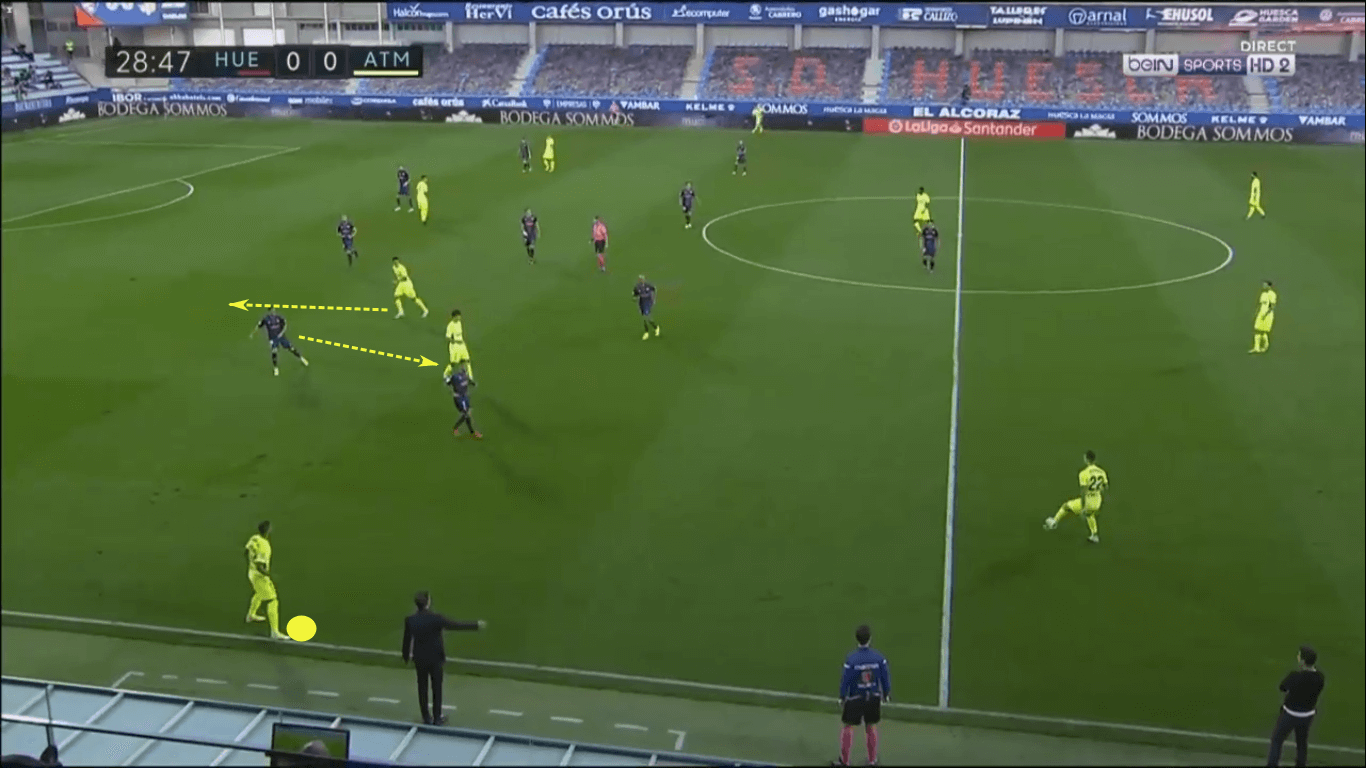
When Félix checked into the midfield, Vitolo would run into the space his teammate vacated. Lodi remained wide during that switch, hoping to either draw an opponent away from the press or receive in open space.
If the first rotation didn’t work, the pair would try again, as highlighted below. Notice in each image that López, the Huesca right-back, has the situation well under control. He didn’t bite on the checking runs, leaving space in behind for the runner.
You’ll also notice the inactivity of Lodi. One of the reasons Los Rojiblancos struggled to progress was the predictability of the movement in the half spaces. With Hermoso on the ball so often in this match, Lodi didn’t d’ enough to pull López away from the half space, creating room for Félix and Vitolo. Notice the body orientation of López. Lodi, Hermoso and the checking player are always in his direct line of sight. To create more space for the runner, feigning a run down the wing would have created more space for both Félix and Vitolo. One could receive between the lines, the other would have more space over the top in the half space.
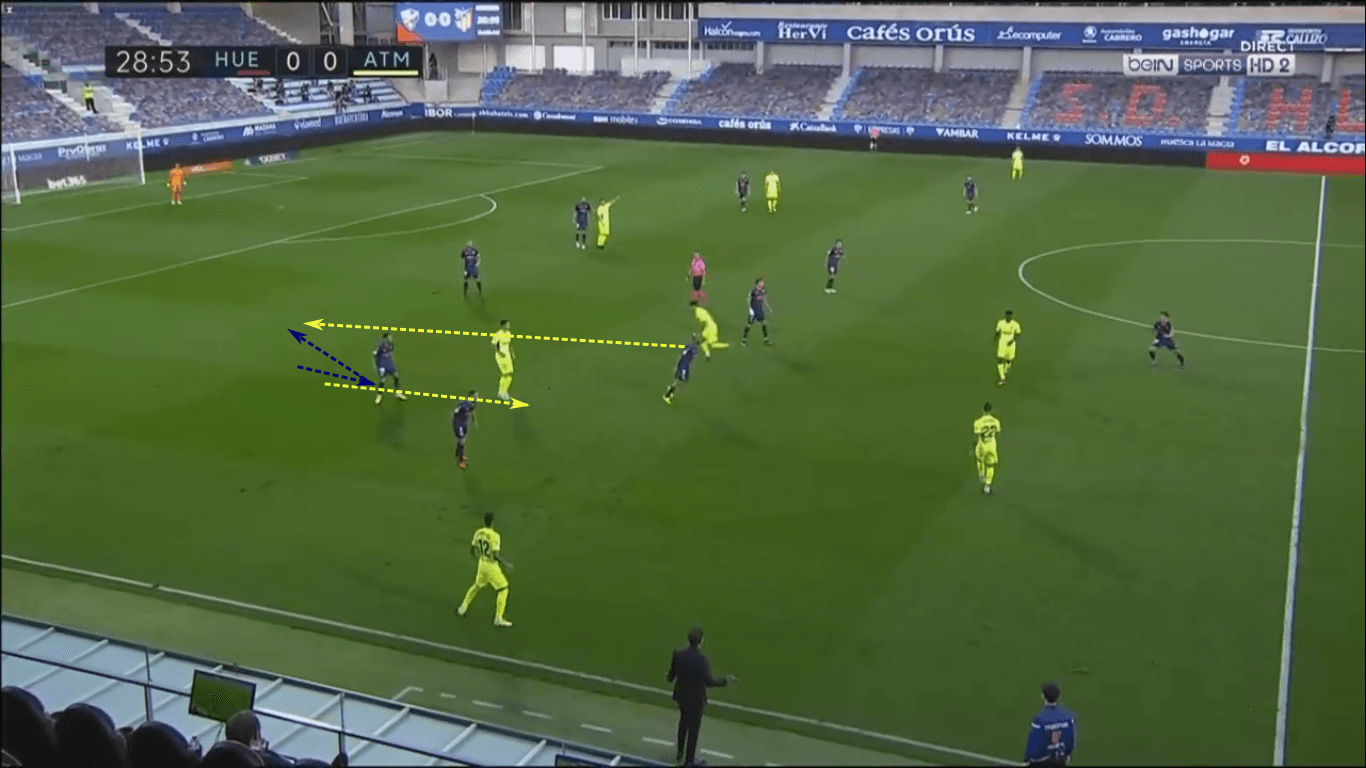
Now, don’t take the above rant as saying Lodi didn’t fill a role. He did offer width, send in crosses and make the occasional progressive run, as seen below. With the ball on the right half of the pitch, Lodi made a nice run behind the Huesca backline. The pass was completed, but he scuffed the play in the end. Regardless of the endpoint, the sequence was well constructed, allowing Atlético Madrid to break the tough low block.
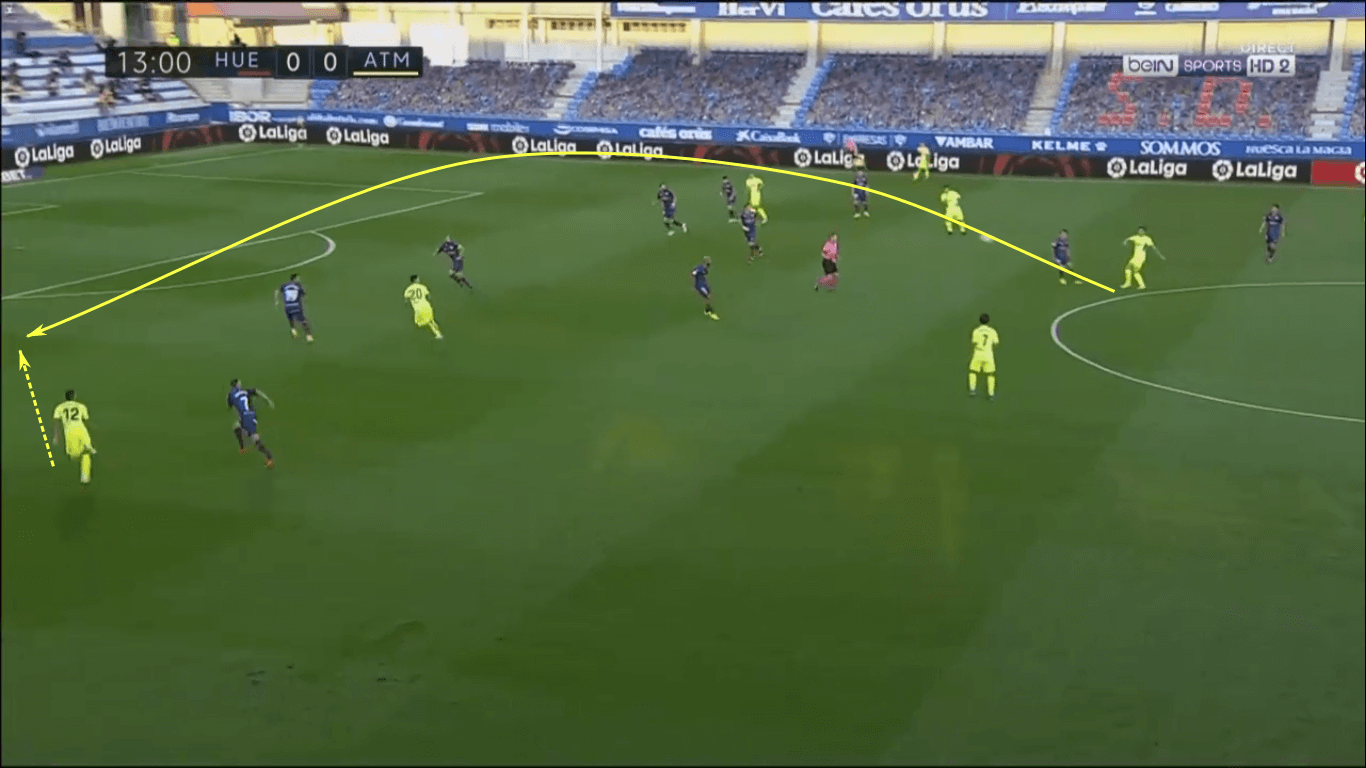
In the later stages of the game, Atléti had more success getting around the Huesca low block and sending dangerous deliveries into the box. Diversifying the attack sooner would surely have kept the opponent off-balance. With Atlético so heavily concentrated in the centre, greater creativity and production in the wings was necessary.
Late-game adjustments
Speaking of the later stages of the game, it was really in the final 25 minutes that Atlético Madrid came to life. Coming off a debut brace against Granada, Suárez didn’t offer much in this game, prompting the swap for Diego Costa. Although Costa didn’t register a single shot in this match, his contribution was undeniable. Of Atlético’s 0.97 xG, 0.84 came after Costa entered the match. Félix was the main beneficiary, finding himself with more time and space in front of the Huesca backline and recording five shots in the final 25 minutes.
Yannick Carrasco entered with Costa, taking Llorente’s place, but moving to the left side of the formation, while Ángel Correa operated in the right half space. The three subs pushed high up the pitch, frequently running behind the lines to manipulate the opposition. That gave Félix more space between the lines, as seen below.
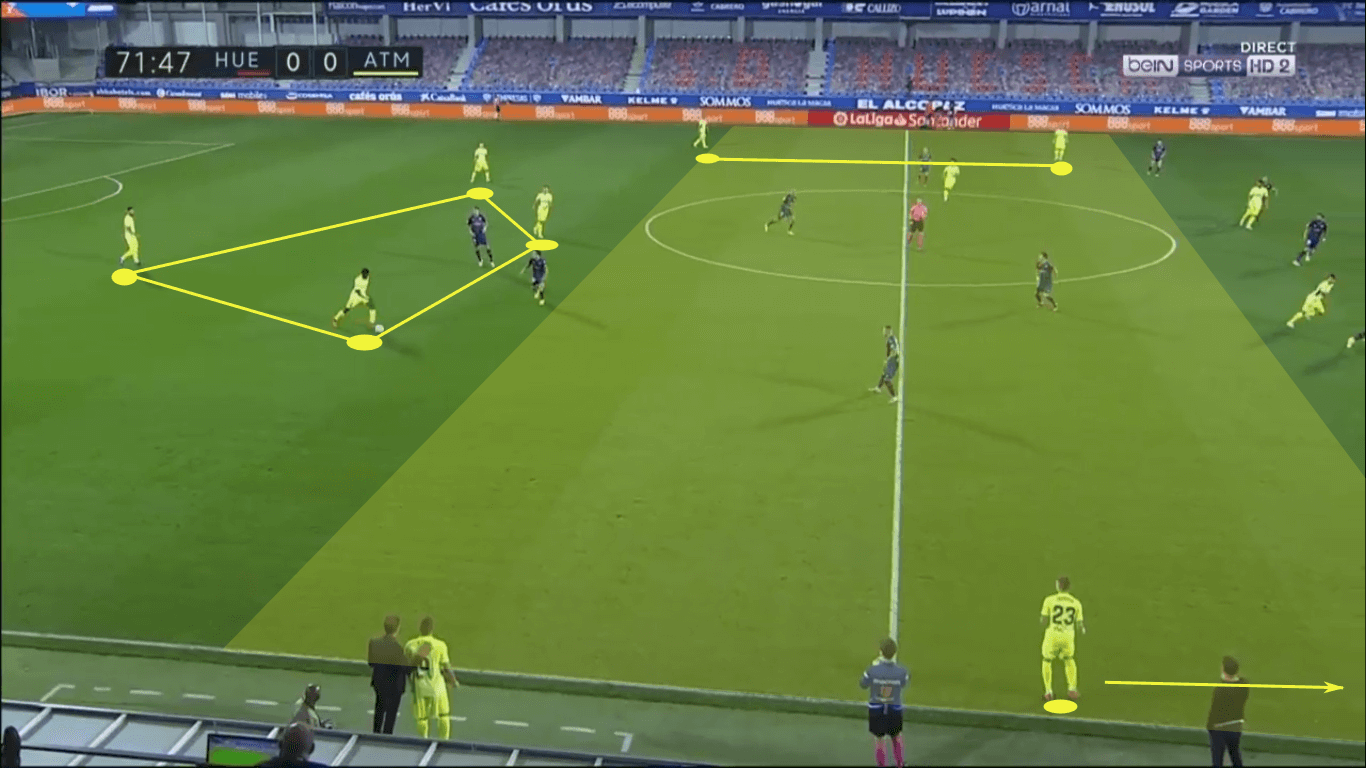
Another important aspect of the change in tactics was the four-man square at the back of the formation. Partey and Koke dropped deeper to help with the build-up, leaving a massive gap between them and the forwards. Félix and the outside-backs were frequently the only Atlético Madrid in that gap.
If the line breaking passes or ball over the top weren’t on, Atlético opted for a more patient approach. Costa remained high, looking to stretch the lines, but Correa and Carrasco were then free to drop between the lines to receive. Since they had already created space between the lines with runs in behind, their checks into the midfield generally resulted in more time and space on the ball, as seen below.
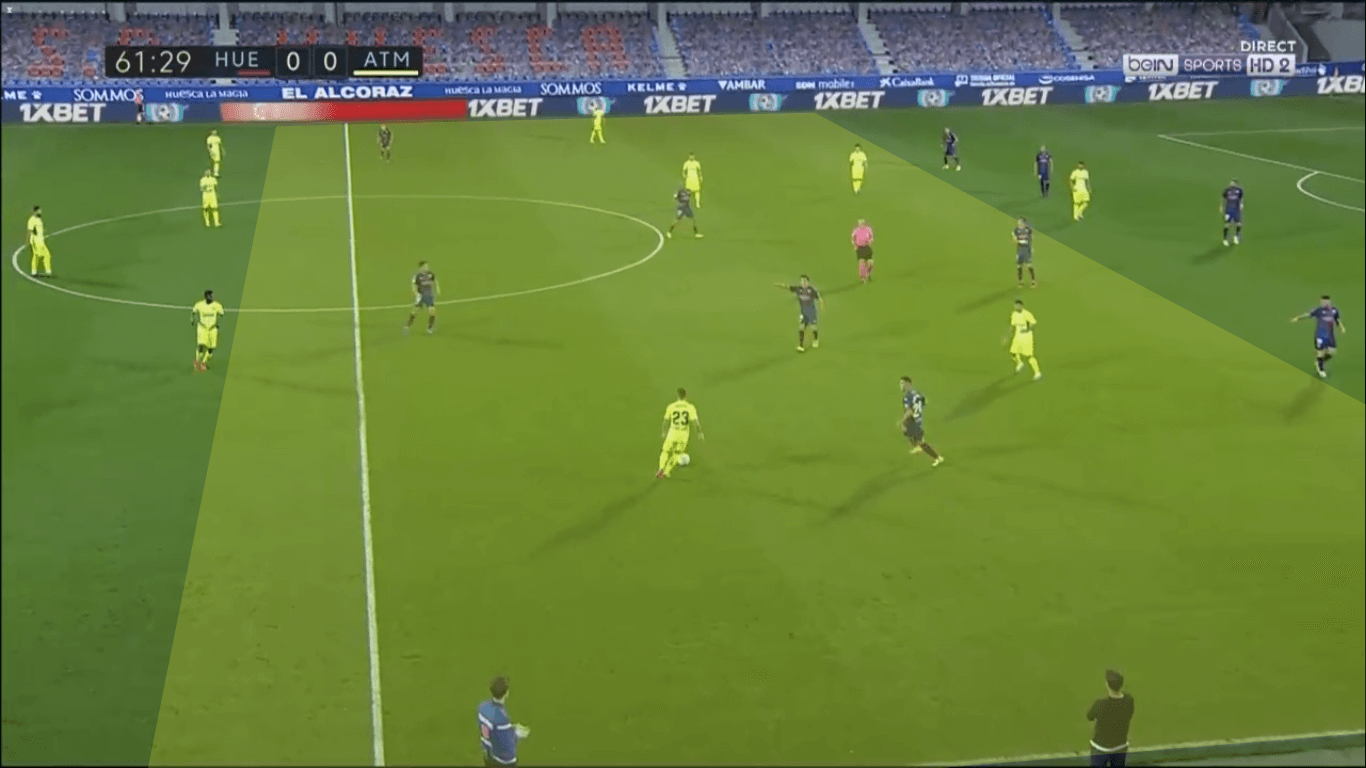
For Huesca, the chore was finding the right balance to close out the match. Three points would have suited them just fine, but they were more than happy to take a point from one of Spain’s big three. In attack, there was more of an initiative to counterattack through the half spaces through the forwards and wingers. They did manage to produce a couple of decent opportunities in the final 25 minutes, but being pinned so deep clearly took its toll.
In the end, the adjustment they made was a subtle one, but, again, the objective was balance. As Atlético Madrid possessed near midfield, Huesca remained in their tight 4-4-2 defensive structure.
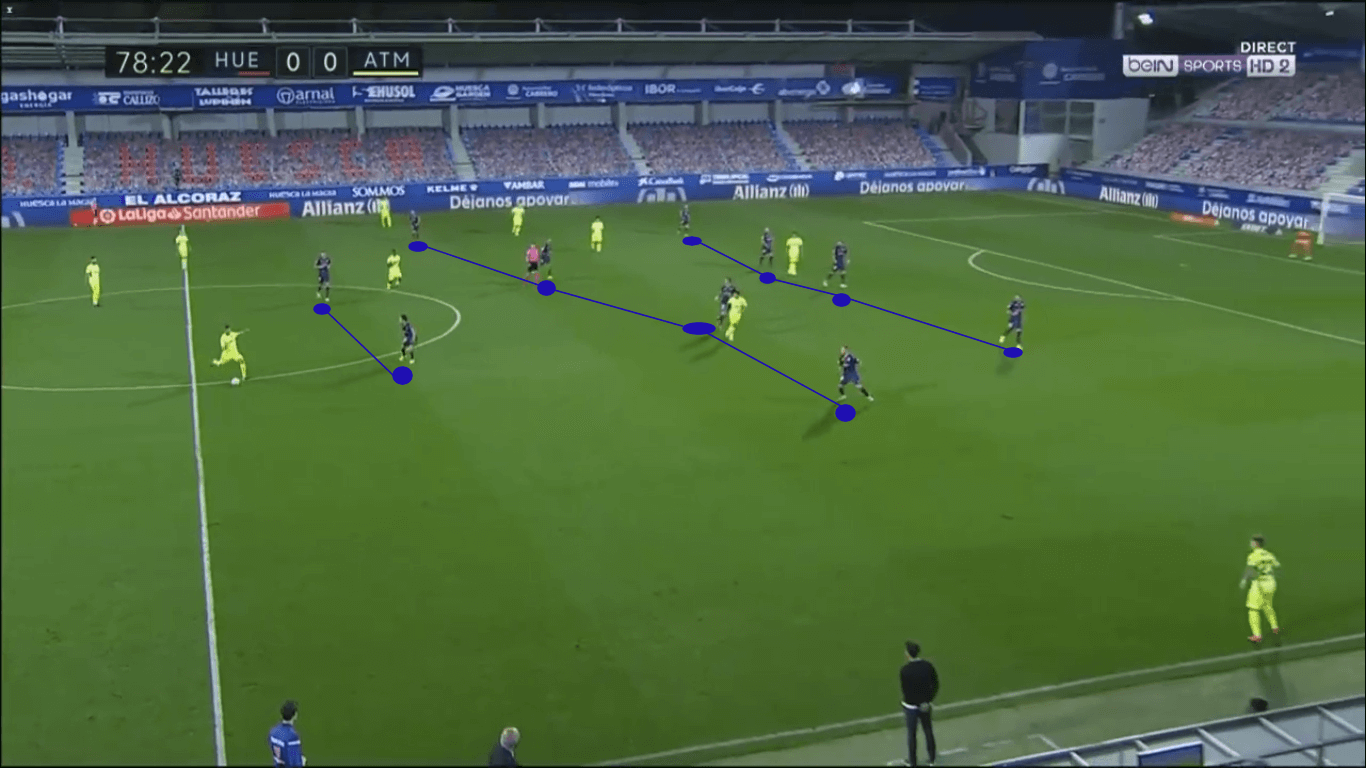
When the ball was played wide, as in the image below, the far sided midfielder cheated forward. In part, this was to contest any pass played to the far sided centre-back. The other aspect was to be an outlet in transition.
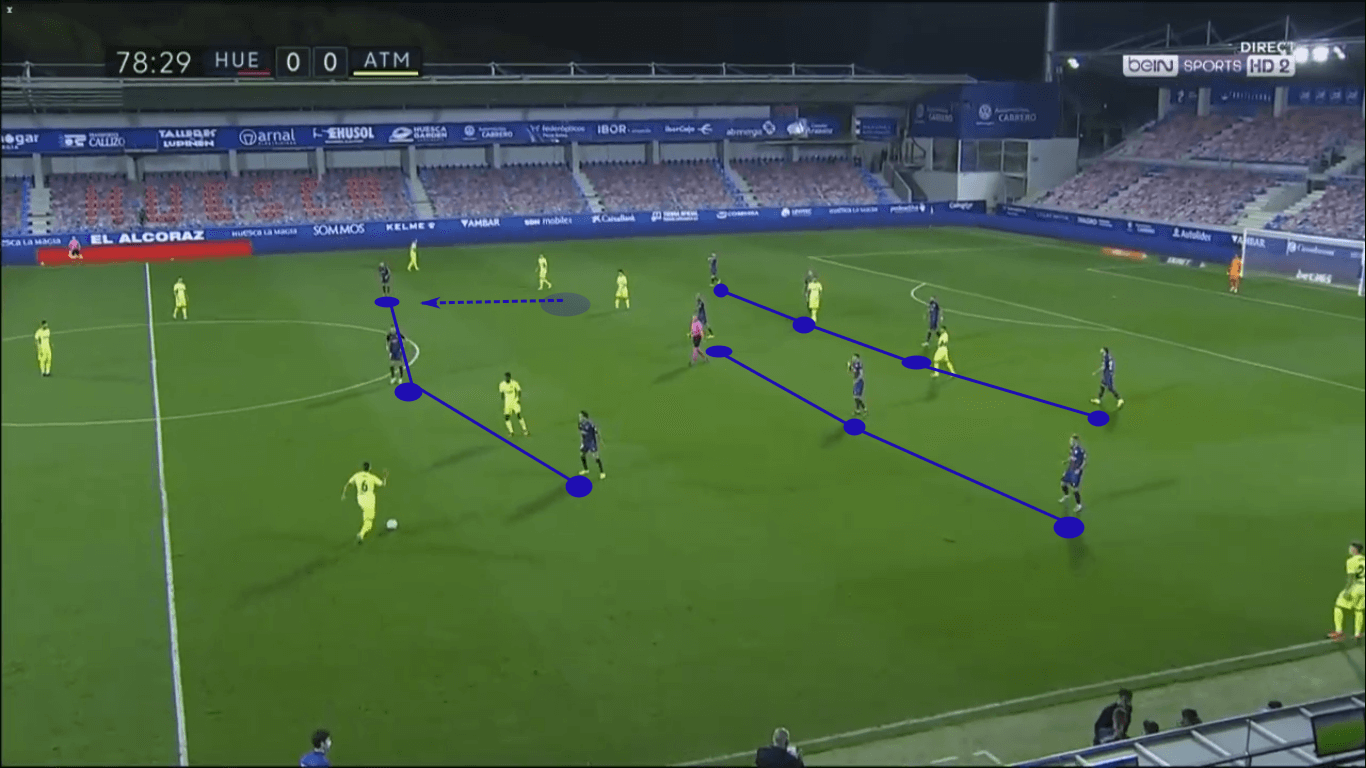
The above image captures the moment immediately following a switch of play to Trippier, followed by the negative pass to Filipe. Sergio Gómez, who came in at right-midfield, pushed higher up the pitch, leaving his deeper supporting cast to account for the left-sided Atlético overload. While it did open them up at the back, giving Atlético Madrid a number of quality opportunities to close the match, Míchel’s gamble didn’t come back to haunt him. It was a subtle change of tactics, but one that led to a more open ending.
Conclusion
Simeone and his squad surely won’t be happy with this result or the performance. Coming off the thrashing of a strong Granada side, more was expected of Atlético Madrid, especially against a recently promoted side. Though they had a few quality opportunities, it’s troublesome that only two of 16 shots were on frame. Too many shots from distance and little composure in the box, two glaring deficiencies from the previous season, came back to bite them.
Though Atlético Madrid didn’t play particularly well, credit goes to Huesca for their highly disciplined performance. Míchel’s tactics were spot on, leading his side to an important point against a top La Liga side. Given the performance against Granada, few expected Atlético Madrid to stumble against Huesca, that despite a string of strong performances in their La Liga return.
Each club has one more game before the international break. Huesca takes on fellow La Liga2 promoted side Elche while Atlético Madrid prepares to host Villarreal.




Comments